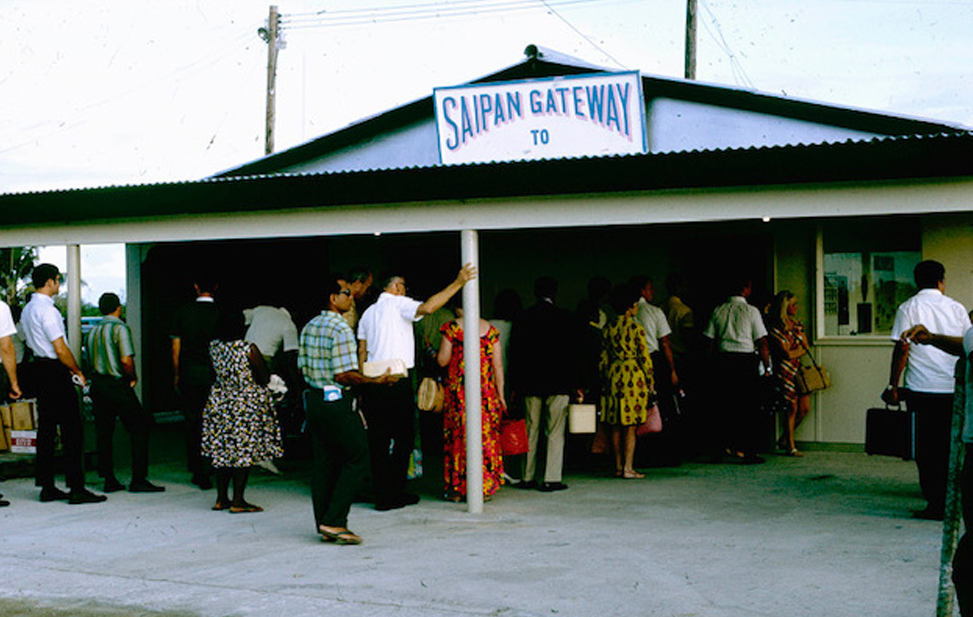
Kobler Field was Saipan’s main airfield until July 1976.
THE NMI became self-governing in 1978. From 1945 to 1977, the islands were administered by the U.S. as part of a United Nations Trust Territory. It was the U.S. military, which invaded the islands in 1944, that formed the first post-World War II government in the NMI.
In his 1954 book, “Saipan: The Ethnology of a War-Devasted Island,” Alexander Spoehr wrote that after “capturing” Saipan, the U.S. military transformed the island “into an immense military base.” Before the war, the NMI and the other Micronesian islands ruled by Japan enjoyed economic development and were financially self-sufficient. Under the U.S. military, in contrast, a “local economy soon developed that depended essentially on government employment. The extent of farming…was minimal,” Spoehr noted.
By the summer of 1950, however, the Army and Navy base installations had closed, he said. The result was a financial crisis. “Saipan,” according to an economic survey board report, “is at present in the worst economic straits of the inhabited islands of the northern Marianas chain. Saipan’s economy since the war has become established on a false, untenable basis, almost complete reliance on wages paid by the military for types of work that contribute nothing to the real wealth of the island.”
Adding to the problem was Don A. Farrell’s observation in “History of the Northern Mariana Islands” that living off the land was much more difficult than before the war. “Most of the coconut trees, breadfruit trees and banana plants had been destroyed,” he said. “The soil was ruined. The cattle, pigs and goats were dead. It was many years before these problems were overcome.”
Twenty years after the war, a visiting American writer, E.J. Kahn Jr., noted that Garapan was once the pride of Saipan. He said other “war-torn cities have [already] risen from their ashes [but] Garapan is still nothing.” Meanwhile, according to Kahn, the U.S. administration of the islands had created a “subsidized economy.”
For the late local economist William Stewart, “Those were the days when the islands were still largely devoid of many of the amenities of the mid-20th century, amenities that one would normally associate with a developed economy. In fact, there was no economy worthy of the name….”
In those benighted days, Stewart said, “to get to Saipan from Guam one transferred to an ancient four-engine, 84-seat DC6, which flew with its onboard mechanic and a bunch of spare parts for a 45-minute flight to Saipan’s brush-lined, unlighted, coral airstrip at Saipan International at the southern end of the island. Saipan’s airstrip had no control tower and a flyby was necessary to check the wind direction and scare away any stray dogs or cattle that might have wandered onto the weed infested landing path of World War II’s Kobler field situated at the southern tip of the island. Disembarking from the aircraft one entered a small, dilapidated, sun-bleached, corrugated tin structure without doors and without glass in open air windows furnished with several roughly hewn wooden benches.”
As for the island’s roads, they were “largely pot-holed and were either choked with coral dust during dry periods or deep, water filled, bone shattering, axle breaking craters that had remained unimproved since the U.S. military left years before…. Middle Road was almost entirely undeveloped. It was another pot-holed, two-lane, dusty road with hardly a business on either side. The maximum speed possible was about 20 – 25 mph.”
Those were the good ol’ days before the NMI, finally self-governing, undertook a broadly successful drive for economic growth in the mid-1980s.
Today, unwilling to learn anything from history, some NMI officials want us to return to an economy subsidized by the feds and/or the military. They see no issue in replacing one dependency (tourism) with another (feds/military). Tourism, they say, is “too volatile.” As if relying on the military is no different. The military’s needs, like everything else, can change in an instant depending on events over which the NMI has no control. Moreover, all economies, including in developed nations such as the U.S., are subject to boom-bust cycles.
As for those who say the NMI should aspire to be like Guam, which has a large U.S. military presence. Sure. But the “backbone” of Guam’s economy is tourism, attracting over 1 million visitors a year prior to the pandemic.
For the NMI, the way forward is to embrace “all of the above.” Revive the tourism economy, welcome more military presence, and tap into other possible economic activities in this fast evolving digital and AI world.
The NMI, in other words, should continue to exercise its right to self-government by pursuing economic development that is tailored to the needs of its people, rather than the priorities of distant politicians and officials in Washington, D.C.
Send feedback to editor@mvariety.com











